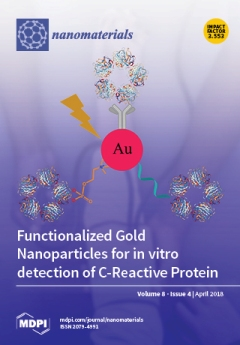In this study, sol-immobilization was used to prepare gold nanoparticle (Au NP)-decorated titanium dioxide (TiO
2) photocatalysts at different Au weight % (wt. %) loading (Au
x/TiO
2, where
x is the Au wt. %) and Au–M NP-decorated TiO
2
[...] Read more.
In this study, sol-immobilization was used to prepare gold nanoparticle (Au NP)-decorated titanium dioxide (TiO
2) photocatalysts at different Au weight % (wt. %) loading (Au
x/TiO
2, where
x is the Au wt. %) and Au–M NP-decorated TiO
2 photocatalysts (Au
3M
3/TiO
2), where M is bismuth (Bi), platinum (Pt) or palladium (Pd) at 3 wt. %. The Au
x/TiO
2 photocatalysts exhibited a stronger visible light absorption than the parent TiO
2 due to the localized surface plasmon resonance effect. Increasing the Au content from 1 wt. % to 7 wt. % led to increased visible light absorption due to the increasing presence of defective structures that were capable of enhancing the photocatalytic activity of the as-prepared catalyst. The addition of Pt and Pd coupled with the Au
3/TiO
2 to form Au
3M
3/TiO
2 improved the photocatalytic activity of the Au
3/TiO
2 photocatalyst by maximizing their light-absorption property. The Au
3/TiO
2, Au
3Pt
3/TiO
2 and Au
3Pd
3/TiO
2 photocatalysts promoted the formation of glyceraldehyde from glycerol as the principle product, while Au
3Bi
3/TiO
2 facilitated glycolaldehyde formation as the major product. Among all the prepared photocatalysts, Au
3Pd
3/TiO
2 exhibited the highest photocatalytic activity with a 98.75% glycerol conversion at 24 h of reaction time.
Full article






